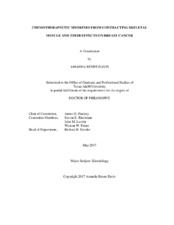| dc.description.abstract | Exercise has been shown to elicit beneficial effects in both the treatment and prevention of cancer, yet the biology potentiating the effects remains ambiguous. The hypothesis for this dissertation was that effluent perfusion medium from contracting skeletal muscle contained factor(s) responsible for the cytotoxic effects of exercise on breast cancer cells. To date, no studies exist designed to eliminate confounding humoral factors, in vivo, while still mimicking the effects of exercise via neural activation of the muscle. We addressed this issue by stimulating the muscle via neural activation using an in situ, hemicorpus hind limb perfusion preparation. To assess the acute impact of muscle contractions on breast cancer, we first collected medium perfused through quiescent (Non-STM) muscle, subsequently followed by medium collected from contracting (STM) muscle of rats. To determine if the acute impact of contracting muscle is altered by prior muscle conditioning, we compared acute responses of muscle contraction on breast cancer from control (Non-EX) vs. treadmill exercised (EX; 5d/w; 1h/d for 5w) rats. We also assessed the impact of a common carrier of molecules in the bloodstream, by preparing the perfusion medium with or without albumin, using Dextran as the oncotic agent for these experiments.
The results of these studies confirmed our hypothesis that effluent media prepared with albumin from contracting muscle (STM) displayed an average percent reduction of MCF7 cell counts by 20% (p = 0.014) compared to Non-STM, and prior exercise conditioning did not alter this effect (STM = EX; p = 0.563). Albumin-prepared medium yielded similar cell counts as cell controls. Interestingly, the chemotherapeutic effect was not present using medium prepared with Dextran, with or without STM, suggesting albumin as a carrier molecule that is necessary for chemotherapeutic activity. To our knowledge, our results support a decrease in MCF7 cell proliferation from a factor secreted from contracting skeletal muscle, independent of humoral contributors; and are the first to demonstrate that the magnitude of the chemotherapeutic effect of contracting skeletal muscle is not altered by prior exercise training, suggesting that muscle contractions are the key contributors to this anticancer effect and not a result of a training adaptation. | en |


